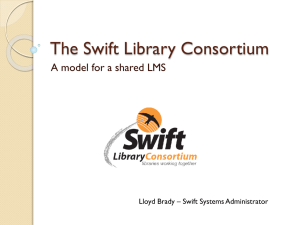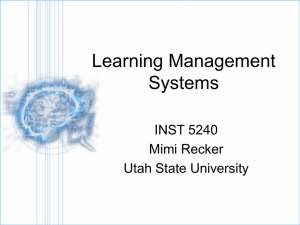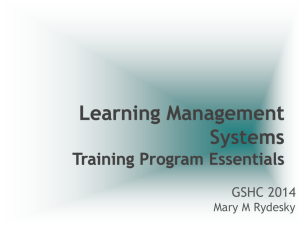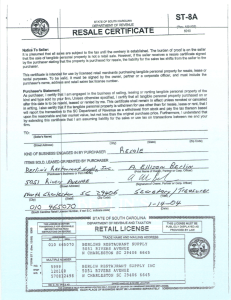Course - Moodle USM
advertisement
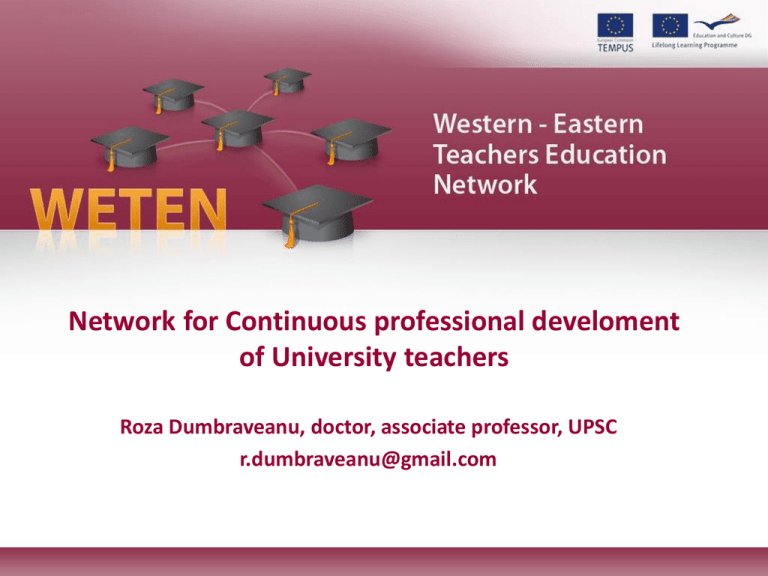
Network for Continuous professional develoment of University teachers Roza Dumbraveanu, doctor, associate professor, UPSC r.dumbraveanu@gmail.com Challenges • • • • • Globalization Knowledge society Labour market needs Higher Education Area Bologna objectives Needs analysis • Professional development of the academic staff has an important contribution to make in the realisation of the Bologna objectives • Entire curricula are reconsidered • Increasing demands made on academic staff • The focus on restructuring of teaching and learning • From teacher training approach to student centered learning Needs analysis • The new teaching methods implies substantial reform of the initial and inservice training of teachers to prepare them for their new responsibilities, in particular by highlighting the unique contribution to learning of teachers as such. • To date, however, the provision of formal retraining for teachers from Higher Education Institutions from eastern countries is seldom and uncoordinated. HE eastern teachers' problems • • • • • • • • • • • Very few opportunities for professional retraining Insufficient Knowledge in HE didactics Insufficient pedagogical level of newcomers Insufficient teachers’ experience Lack of HE standards Cohorts of students Lack of students’ motivation for studies Low entry level of students’ knowledge Extra number of teachers’ activities/responsibilities Number of teaching hours Low salary level ENQA requirements • From European standards and guidelines for internal quality assurance HEI - quality assurance of teaching staff: • institutions should have ways of satisfying themselves that staff involved with the teaching of students are qualified and competent to do so. ENQA requirements • From European standards and guidelines for internal quality assurance HEI - learning resources and student support : • institutions should ensure that the resources available for the support of student learning are adequate and appropriate for each programme offered. ENQA requirements • From European standards and guidelines for internal quality assurance HEI - information systems : • institutions should ensure that they collect, analyse and use relevant information for the effective management of their programmes of study and other activities . Reality • The response and information provided to the mentioned ENQA requirements by HE institutions of partner counties is far not enough. • Misunderstandings occur also due to lack of appropriate training and information accessible to teachers and students. ENQA requirements • From European standards and guidelines for internal quality assurance HEI - public information : • institutions should regularly publish up to date, impartial and objective information, both quantitative and qualitative, about the programmes and awards they are offering . Network objectives • To develop an online community to exchange ideas, content, educational resources; • To identify the existing material and produce courses for training the HE staff • To train academic staff from eastern HEI in using new methodologies; To promote and disseminate the network findings. Course “Curriculum design in Higher Education” Responsible partners: UPSC, UA Delivery mode: • In accordance with target groups needs and peculiarities. • Blended learning agreed during internal project partners’ discussions. Target groups • General: Teaching staff from HEIs • Within project: Partner institutions teaching staff & master degree students (partly involved in HEI teaching) • Mainly: teaching staff from education science faculties, foreign language department, psychology department, ITII, master students ITII. Selection of trainees Selection of trainees: Distribution of information about courses 1. Web site announcement 2. Discussions at departments 3. University senate announcement 4. Description of the course available on the web site 5. Other events (seminars, meetings) 6. Direct discussions with potential trainees Course enrolment Enrolment 1. Via email 2. Selection lists from departments 3. Direct enrolment via LMS facilities (needs confirmation) 4. Distribution in groups Target groups Target groups enrolled: UPSC: Teaching staff from departments: pedagogy, ITII, continuing education, psychology, foreign languages, others. Master degree students from faculty Informatics and Information technologies in education USB: teaching staff from different faculties (mainly heads of departments, deans) UST: project team members, heads of departments Quality of teaching To improve the quality of teaching and learning in HEI: • What does this mean? • How these courses will improve the quality of teaching and learning in HEI? • Bologna demands: redesign of curricula; from teacher centered to student centered, focus on Learning outcomes Curriculum design in HE COURSE LEARNING OUTCOMES At the end of the course, the participant should be able to: • 1. Apply curriculum design theory to the design of a specific course • 2. Engage in effective teaching and designing learning activities Course learning outcomes • Apply curriculum design theory to the design of a specific course – Develop a course systematically based on design principles. – Demonstrate the use of curriculum mapping. – Define relevant learning outcomes. • Evaluate the strengths and weaknesses of various teaching strategies in relation to defined learning outcomes. • Evaluate the strengths and weaknesses of various assessment methods in relation to declared learning outcomes. • Develop a complete course plan and course outline. Course learning outcomes • Engage in effective teaching and designing learning activities – Demonstrate skills in presenting teaching content and choosing appropriate teaching strategies. – Demonstrate skills in organizing learning activities. – Implement alignment approach in the design of the selected course. Course structure 6 units • Unit 1: Curriculum design principles • Unit 2: Curriculum map • Unit 3: Learning outcomes (LOs) • Unit 4: Effective teaching and learning • Unit 5: Student Assessment • Unit 6: Alignment approach LOs/Teaching&learning/Assessment~ LOLA or TLA Course delivery Approach: • Face to face meetings • Virtual environment (MOODLE LMS) Prerequisites: • Basic Computer skills • Participation in courses 4 and 5 (required/optional) Course delivery Required Competences from other courses • How to work in a LMS • Use of collaborative tools • ICT tools and their effective use in the curriculum design • Effective web search and criteria for evaluation of resources Course materials • • • • Teaching aids in printed format Course in a LMS/MOODLE Links to web resources Articles, documents in digital format Teaching techniques used Teaching techniques differ: slightly different for different target groups. The main focus: Blended learning and constructivist approach in different proportion Course delivery I. Pilot phase, two courses in parallel: (objectives: to enhance ICT competences of trainees; to embed ICT competences with curriculum design course learning outcomes) II. ITII master degree students (to discover in a constructivist manner the LMS, to build a course in LMS) III. Next groups ( to fulfil the learning outcomes of the course Curriculum design in HE) Teaching techniques: 21st Century Learning Requirements Teacher-directed Direct Instruction Knowledge Content Basic Skills Theory Curriculum Individual Classroom Summative Assessments Learning for School A Better Learner-centered Collaborative Instruction Skills Process Higher-order Thinking Practice Life Skills Group Community Formative Evaluations Learning for Life Balance Teaching techniques: NETTLE summary on teachers’ competences Competences in 5 areas: • • • • • Specify, explain and sometimes negotiate (a) the intentions of learning on a course or programme and (b) the learning and teaching methods to be used Teach and support learning Mark and give feedback on student work Review and understand the effectiveness of their teaching Continue to improve the effectiveness of their teaching. Teaching techniques used • Home readings • Designed tasks related to the course design matters and teaching practice • Collaborative learning (via LMS and in classrooms) • Based on designed learning activities: LOLALA (Learning outcomes/learning activities/learning assessment) • Workshops and f2f sessions • Feedback on tasks from trainees Tips on teaching practice • LOs: explanations (difficulties to distinguish from objectives and outcomes) • Examples from other universities (difficult to find, not in accordance with LO theory: Tuning new guide) • Guidance on the tasks (the task done do not fit the task requirements) • Assessment tasks in electronic format (teachers do not have the needed skills) • Discussions of the assessment results: continuous Feedback • Focus on results not on grades • Evaluation based on contribution, oral presentations Conclusions & suggestions & problems Sources for course improvements: • Team opinions • Trainees’ opinions • Partners’ opinions Collected via face to face discussions and feedback, as well as from anonymous questionnaires Conclusions & suggestions & problems Feedback from trainees on: • Course content (clear Los, structure, access to materials) • Learning resources (usefulness, relevancy) • Learning environment and teaching methods • Quality of delivery (pace of delivery, motivation to reflections, etc.) • Assessment (methods and feedback) • Learners’ contribution (participation, time devoted, progress) Conclusions • The course is actual, needed and useful for the improvement of teachers’ own courses. • The participants involvement in the course was different: some participated actively with oral and written contributions and made real progress; some were neutral (passive learners). • Time intended initially for the course was extended, according to participants’ needs. • Learning resources were appreciated at very high level. Conclusions & problems • The participants enjoyed the learning environment, the TLA used motivated participation. • LMS is flexible for continuous course updating. • As for using LMS in their own teaching, some discussions appear around topics: • The difference between teachers using a LMS and those using traditional methods. • The copyright issues (access) on materials placed in MOODLE. • Teacher workload • Suggestions: recommendations to university board in this regard (under consideration). Conclusions & suggestions • The course deals with actual matters, very useful for the enhancement of the quality of Higher Education. • Almost all participants would recommend this course to colleagues. • Decision: to include it for continuous teacher development. • The open learning climate stimulated collaboration and the participants learned from each others. • Peer and trainers feedback was helpful. Conclusions & strengths • • • • • • Quality of learners’ contributions. Use of learners’ experience in the field. Collaborative learning. Open learning environment. Constructivist approach was used implicitly. Tasks/assignments related to the real teaching activities. • LMS course materials can be updated easily any time. Conclusions & suggestions & weaknesses • Low learners’ online collaboration. • Not all participants are able to understand English resources (translation is needed). • Difficulties to find time period suitable for all participants for F2F sessions (small group sessions organized). • The majority of participants were not ready to use a LMS. • The participants are more acquainted with traditional model of teaching, waiting from the trainer usual lectures and explanations. • The participants are not familiar with constructivist approach in practice. Conclusions & suggestions & action plan • To implement templates for short version of the course descriptions on the university web site. • To work with teachers that redesigned their courses in accordance with the alignment approach to improve the courses quality. • To continue to deliver the course to new participants in combination with courses on LMS. • To focus on using and promoting online collaboration tools. • To offer consultancy services for using MOODLE environment • To devote more time to the course administration in LMS. Conclusions & suggestions & problems • • • • Learning how to learn (for Master degree students) Defining learning outcomes, relation with competences Criteria for used resources Academic prerequisites for the course (effective search, advanced structuring and formatting of learning content, requirements for professional presentations, etc.) • Using LMS: desired, but … – Teachers’ copyrights on course materials – Motivation, workload, suggestions to university board • • • • F2F? Discussion in forums (not common) Lack of time vs. needs and willings Time required: who is evaluating really the workload? Resources: not available or English version How to Become an Excellent Tertiary-Level Teacher 7 golden rules for university lectures • • • • • • • Find out how your students learn; Set appropriate learning targets; Use appropriate teaching/learning methods; Use appropriate assessment methods; Monitor and evaluate your teaching Always try to improve your performance; Keep yourself up-to-date.
